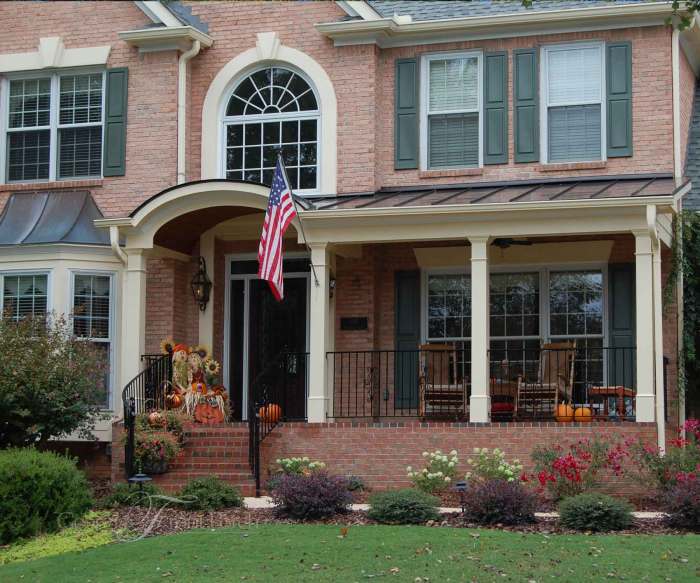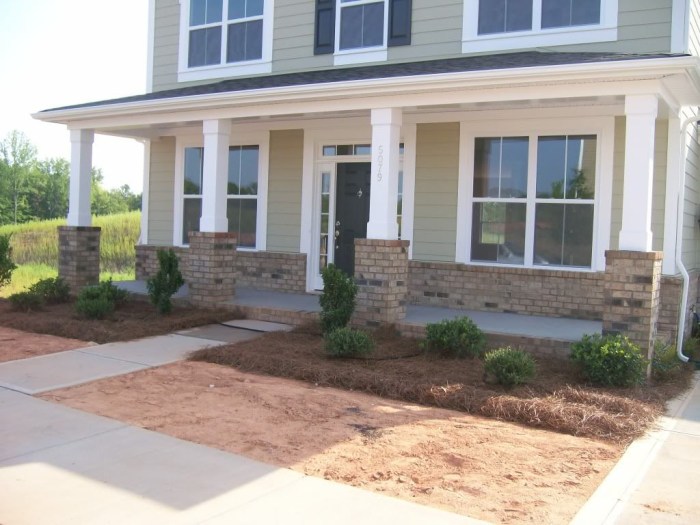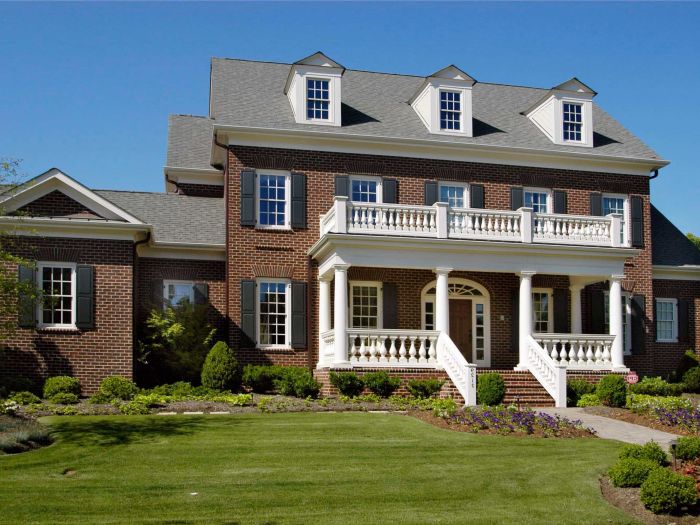Brick porch pillars are a classic and versatile architectural element that can add character and curb appeal to any home. From traditional to modern designs, brick pillars can be customized to complement the style of your home and create a welcoming and inviting outdoor space.
In this comprehensive guide, we’ll explore the different styles, materials, and construction techniques of brick porch pillars. We’ll also provide tips on how to design, decorate, and maintain your pillars to ensure they remain a beautiful and functional part of your home for years to come.
Brick Porch Pillar Styles
Brick porch pillars are a versatile architectural element that can enhance the curb appeal of any home. They come in a variety of styles, each with its own unique history and architectural influences.
Some of the most popular brick porch pillar styles include:
Greek Revival
- Tall and slender with a square or round cross-section
- Often feature a Doric or Ionic capital
- Inspired by the architecture of ancient Greece
Federal
- Similar to Greek Revival pillars, but with a more delicate and ornate design
- Often feature a fluted shaft and a capital with acanthus leaves
- Inspired by the architecture of the early American republic
Victorian
- More elaborate than Greek Revival or Federal pillars
- Often feature a variety of decorative elements, such as moldings, carvings, and finials
- Inspired by the architecture of the Victorian era
Craftsman
- Sturdy and square with a tapered base
- Often feature a battered cap and a simple decorative band
- Inspired by the Arts and Crafts movement
Materials and Construction
Porch pillar construction involves careful selection and use of materials, as well as adherence to proper techniques for laying and bonding bricks. Understanding these aspects ensures structural integrity, durability, and aesthetic appeal.
Brick selection plays a crucial role in the overall strength and appearance of the pillars. Common types of bricks used include:
- Clay Bricks: Durable and weather-resistant, offering a wide range of colors and textures.
- Concrete Bricks: Strong and low-maintenance, often used for their modern and industrial look.
- Paver Bricks: Designed for heavy-duty applications, providing a solid and stable base for pillars.
Laying and bonding bricks require precision and attention to detail. Common techniques include:
- Stretcher Bond: Bricks are laid in alternating rows, with each brick overlapping the joint below it.
- Header Bond: Bricks are laid in alternating rows, with the short ends facing outward.
- Common Bond: A combination of stretcher and header bonds, providing a sturdy and aesthetically pleasing pattern.
Mortar selection is equally important. It serves as the adhesive between bricks, influencing the pillar’s strength and durability. Mortar options include:
- Type N Mortar: General-purpose mortar suitable for most applications.
- Type S Mortar: High-strength mortar recommended for load-bearing structures.
- Type M Mortar: Masonry cement mortar with excellent bonding properties.
Proper grouting seals the joints between bricks, preventing water penetration and enhancing the pillar’s longevity. Grout materials include:
- Mortar Grout: Made from the same mortar used for laying bricks, providing a seamless and durable finish.
- Polymeric Grout: Flexible and water-resistant, suitable for high-traffic areas.
- Epoxy Grout: Strong and chemically resistant, ideal for demanding applications.
Design Considerations
Designing brick porch pillars requires careful consideration of various factors to ensure they complement the overall porch design and enhance its functionality. Here are some key design considerations:
Determining the appropriate size and proportions is crucial for achieving a visually balanced and structurally sound design. The height and width of the pillars should be proportionate to the size of the porch and the spacing between them. Consider the height of the ceiling and the desired level of privacy when determining the height of the pillars.
Incorporating Pillars into the Overall Porch Design
Integrating brick porch pillars into the overall porch design requires careful planning to ensure a cohesive and aesthetically pleasing appearance. Consider the following tips:
- Choose a brick color and texture that complements the exterior of the house and the surrounding landscape.
- Incorporate decorative elements such as caps, bases, and moldings to enhance the visual appeal of the pillars.
- Consider the spacing between the pillars to create a sense of rhythm and visual interest.
- Use pillars to define the entrance to the porch and create a welcoming ambiance.
Decorative Elements
Brick porch pillars can be further enhanced with various decorative elements to create a visually striking and unique appearance. These elements add character and detail, complementing the overall design of the porch and the exterior of the home.
One common decorative element is moldings , which are ornamental profiles that can be added to the base, shaft, or cap of the pillar. Moldings come in a variety of styles, from simple and classic to intricate and elaborate.
They can create a sense of depth and dimension, adding visual interest to the pillar.
Caps , or pillar tops, are another important decorative element. They can range from simple flat caps to more elaborate designs that feature moldings, dentils, or other architectural details. Caps provide a finishing touch to the pillar, enhancing its overall appearance and protecting it from the elements.
In addition to moldings and caps, other architectural details can also be incorporated into brick porch pillars to create a unique and stylish look. These may include:
- Fluting: Vertical grooves carved into the shaft of the pillar, creating a graceful and elegant appearance.
- Pedestals: Bases that elevate the pillar, adding height and grandeur.
- Niches: Recessed areas in the pillar that can be used to display sculptures or other decorative items.
- Arches: Curved openings that can be incorporated into the pillar design, adding a touch of architectural interest.
By incorporating decorative elements into brick porch pillars, homeowners can create a truly unique and visually appealing entryway to their homes. These elements can enhance the overall design of the porch, complement the exterior of the home, and add a touch of personal style.
Maintenance and Repairs
Maintaining brick porch pillars is crucial for preserving their structural integrity and aesthetic appeal. Regular cleaning and sealing prevent damage, while timely repairs address issues before they worsen.
Cleaning
* Use a soft-bristled brush and mild detergent to remove dirt and debris.
- Avoid harsh chemicals or abrasive cleaners that can damage the brick’s surface.
- Rinse thoroughly with clean water.
Sealing
* Apply a clear masonry sealer every 2-3 years to protect the brick from moisture penetration.
- Choose a breathable sealer that allows moisture vapor to escape.
- Apply the sealer evenly with a brush or roller.
Repairs
* Cracked or Loose Bricks: Replace loose bricks with matching ones. Grout cracks using a mortar mix.
Crumbling Bricks
Remove crumbling bricks and replace them with new ones. Consider using a brick hardener to strengthen the surrounding bricks.
Efflorescence
This white, powdery substance is caused by moisture evaporating from the brick. Brush it off and seal the brick to prevent further accumulation.
Water Damage
Inspect pillars for water damage, especially after heavy rain or flooding. Repair any leaks in the roof or gutters to prevent further damage.
Inspiration Gallery
Explore a curated collection of images showcasing diverse brick porch pillar designs, providing detailed descriptions and specifications to inspire your own design choices.
Each image features a unique interpretation of brickwork, from classic to contemporary styles. Discover the versatility of brick as a building material and gather ideas for enhancing the architectural appeal of your porch.
Traditional Square Pillars
- Classic rectangular pillars with a timeless appeal, providing a solid and substantial foundation for the porch.
- Constructed from durable red bricks, laid in a traditional running bond pattern for a uniform and cohesive appearance.
- Features a simple square cap, adding a subtle decorative touch without overwhelming the overall design.
Rounded Tuscan Pillars
- Elegant pillars with a gently curved surface, creating a softer and more inviting aesthetic.
- Crafted from a combination of red and brown bricks, arranged in a herringbone pattern for added visual interest.
- Topped with a rounded cap, further enhancing the smooth and graceful lines of the pillars.
Arched Colonial Pillars
- Distinctive pillars with a graceful arched shape, adding a touch of grandeur to the porch.
- Constructed from white bricks, laid in a traditional stretcher bond pattern for a clean and sophisticated look.
- Features a curved cap with a keystone accent, emphasizing the elegant archway design.
Contemporary Fluted Pillars
- Modern pillars with vertical grooves or flutes, creating a visually dynamic effect.
- Crafted from gray bricks, arranged in a random bond pattern for a more contemporary aesthetic.
- Topped with a flat cap, providing a clean and minimalist finish.
Summary
Brick porch pillars are a timeless architectural element that can add beauty, value, and curb appeal to your home. By following the tips and advice in this guide, you can create a custom pillar design that perfectly complements your home and provides a welcoming and inviting outdoor space for years to come.



